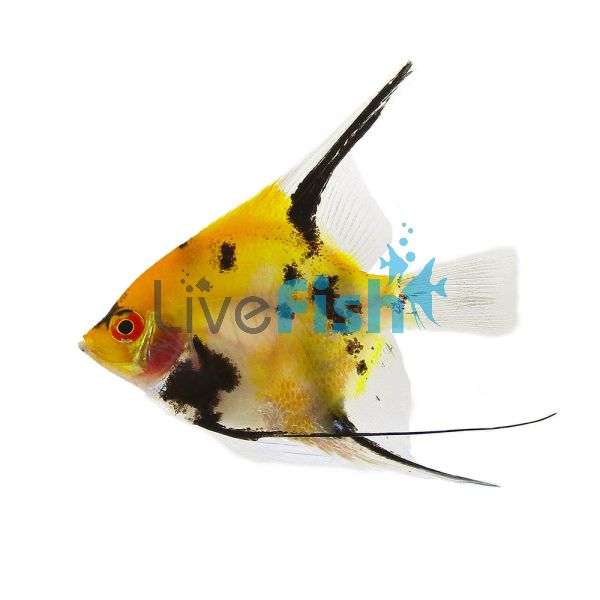Tri-Colour Angel Fish 3.5cm
Tri-colour angelfish has swiftly skyrocketed to be one of the most popular angelfish colour strains at times more commonly available to purchase compared to standard natural angelfish. The diversity of colour variations and how no 2 fish look the same makes these a popular fish for aquarists chasing variety and even for breeders to play around with colours. Angelfish in general are one of the most recognizable aquarium fish species and are actually a member of the cichlid family. Unlike most cichlids which are recognized as being aggressive species that are not suitable in community aquariums, the angelfish is a stark opposite of this. They make for great centrepiece fish in community aquariums and are very easy to keep.
- Buy 3 for $25.02 each and save 20%
- Buy 6 for $21.89 each and save 30%
Tri-Colour Angel Fish
Tri-colour angelfish has swiftly skyrocketed to be one of the most popular angelfish colour strains at times more commonly available to purchase compared to standard natural angelfish. The diversity of colour variations and how no 2 fish look the same makes these a popular fish for aquarists chasing variety and even for breeders to play around with colours. Angelfish in general are one of the most recognizable aquarium fish species and are actually a member of the cichlid family. Unlike most cichlids which are recognized as being aggressive species that are not suitable in community aquariums, the angelfish is a stark opposite of this. They make for great centrepiece fish in community aquariums and are very easy to keep.
Tri-Colour Angelfish gets their name due to the three main colours found on the body yellow, black, and white. These fish are also often sold as koi angelfish due to the three colours found in Showa Koi however koi angels tend to have orange instead of yellow. The main body colour tends to be yellow which is streaked with black stripes and blotches both on the fins and body. The white colouration is mostly isolated near the belly however the positioning of any colour is really unpredictable in each fish which is what makes them so different. These angelfish also have deep red eyes the red gill colour coming through. Angelfish are one of the first species that aquarists will breed because of how proficiently these fish spawn in the aquarium. A lot of fun can be had experimenting with colours and genetics in this strain by trying to isolate the black to specific locations or attempting to deepen the yellow colour. A lot of angelfish in the aquarium trade also have the pearl scale gene which gives them a shimmer that these angelfish lack. Instead, they have a matte, translucent look to them.
Trying to find the males and females, in not only the Tri-Colour Angelfish, but angelfish in general is somewhat difficult when they are small, however dominant males will develop a small hump on their head. One can be 100% certain only when a breeding pair is formed. The best way to ensure this happens is to start with a small group of 5-6 fish and let them pair off naturally. Tri-Colour Angelfish are not found in the wild as they are captive-bred and man-made colour variations however the angelfish in general is from South America.
Tank Recommendations for your Tri-Colour Angelfish
The Tri-Colour Angel is a colour variation of the common scalare angelfish species meaning it has the same aquarium needs as any other angelfish variety. At full adult size, they reach around 15 cm long, and a decent 20 cm tall, because of this they would need to be kept in a tank that is at least 100 litres.
Tri-Colour Angel Fish are not exactly a solitary species and should be kept in mated pairs or shoals. However, they will need space as they can be territorial at times, so having a good footprint in the aquarium is always best. A sand or gravel substrate is perfectly fine, but a well-planted aquarium with lots of branching driftwood and rock will be greatly appreciated by these angelfish.
Suitable Tank Buddies
The Tri-Colour Angelfish is fairly peaceful with aggression only ever coming out during breeding. Males, however, may eat very small fish fry and shrimp. With adequate space, these fish will get along with a wide range of community fish. it has however been noted that angelfish can possibly be aggressive against fish species that look similar.
Usually Compatible
Other Angelfish, Tetras, Gouramis, Corydoras, Barbs, Dwarf Cichlids such as Rams, and large peaceful cichlids such as Uaru or Severums.
Sometime Compatible
Semi-aggressive or territorial cichlids like Firemouths, Convicts Cichlids, and similar species.
Rarely Compatible
Large aggressive species such as African Cichlids, Oscars, and Jaguar Cichlids.
Feeding your Tri-Colour Angelfish
Angelfish in general are a very easy species to feed that will take to a wide range of aquarium foods like pellets or flakes. They are naturally an omnivore that feeds off plant
matter like algae, small insects, and crustaceans. This means a well-balanced aquarium food that has good protein and green content would be best.
| Scientific Name | Pterophyllum Scalare |
|---|---|
| Care Level | Easy |
| Common Names | Tri-Colour angelfish |
| Diet | Omnivore |
| Fish Family | South America |
| Lifespan (years) | 15 |
| Max. Length (cm) | 15 |
| Min. Tank Volume (l) | 100 |
| Origin | South America |
| Reef Safe | Yes |
| Sociability | Peaceful |
| Venomous | No |
| Water Conditions | 24-26° C, pH 5.0-7.0 |




